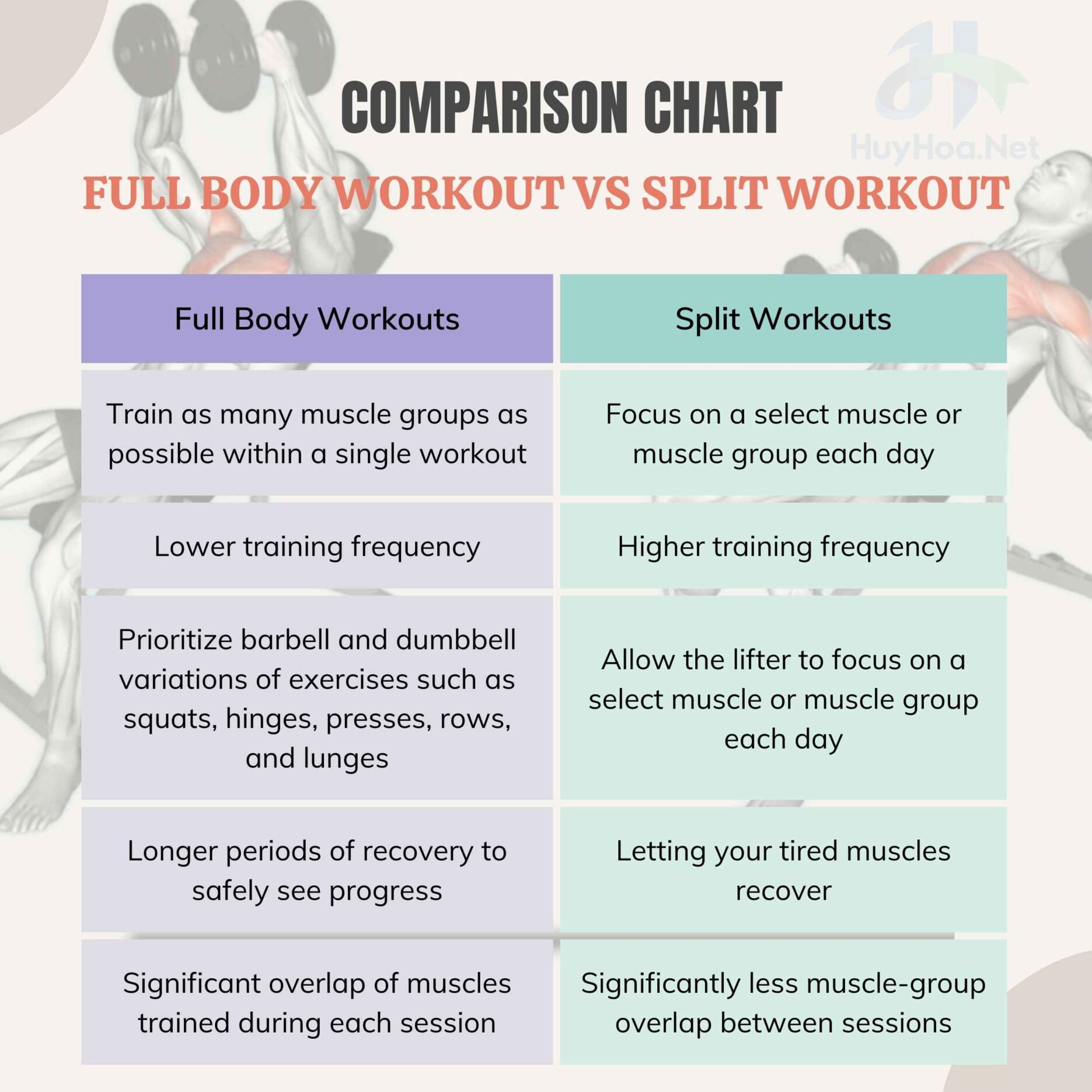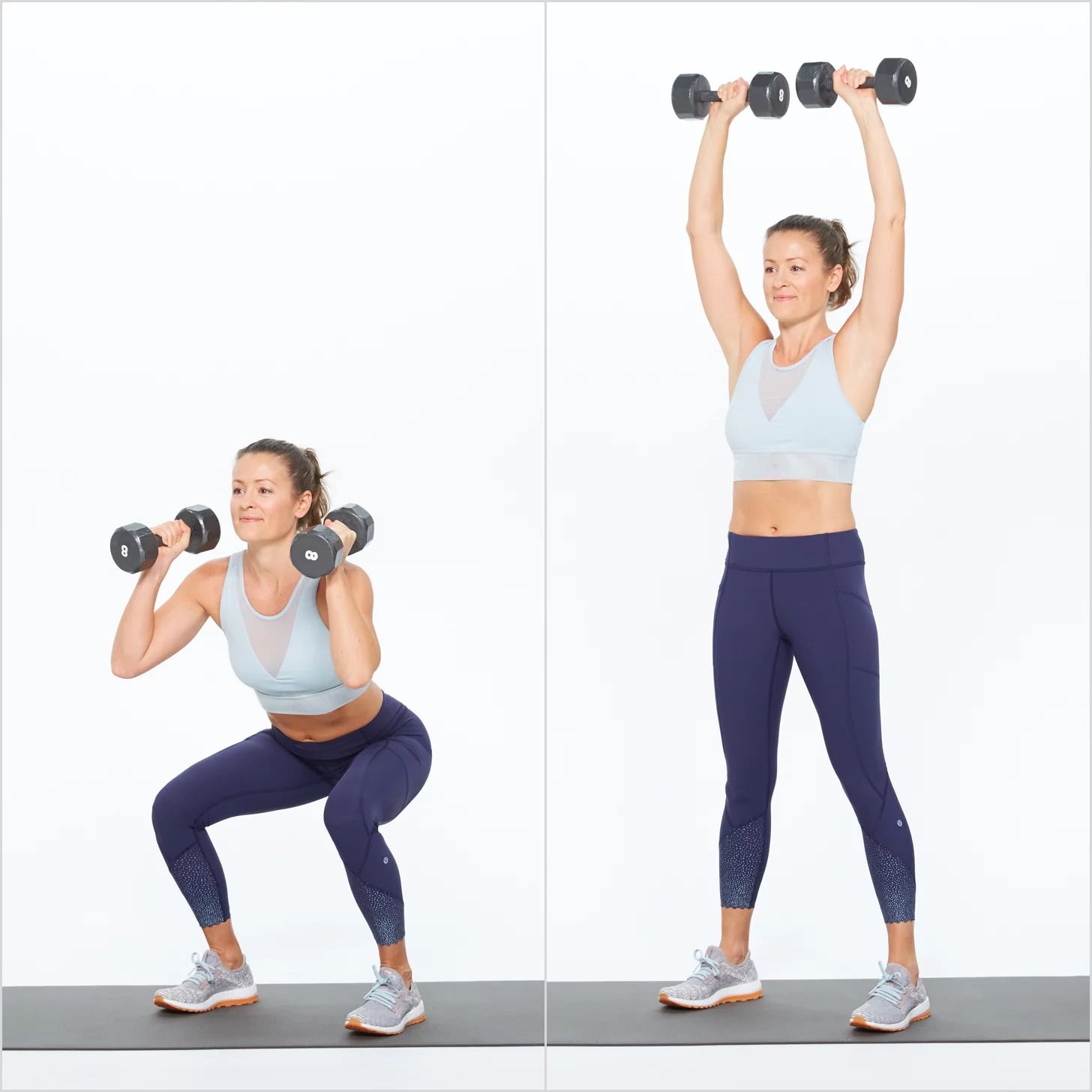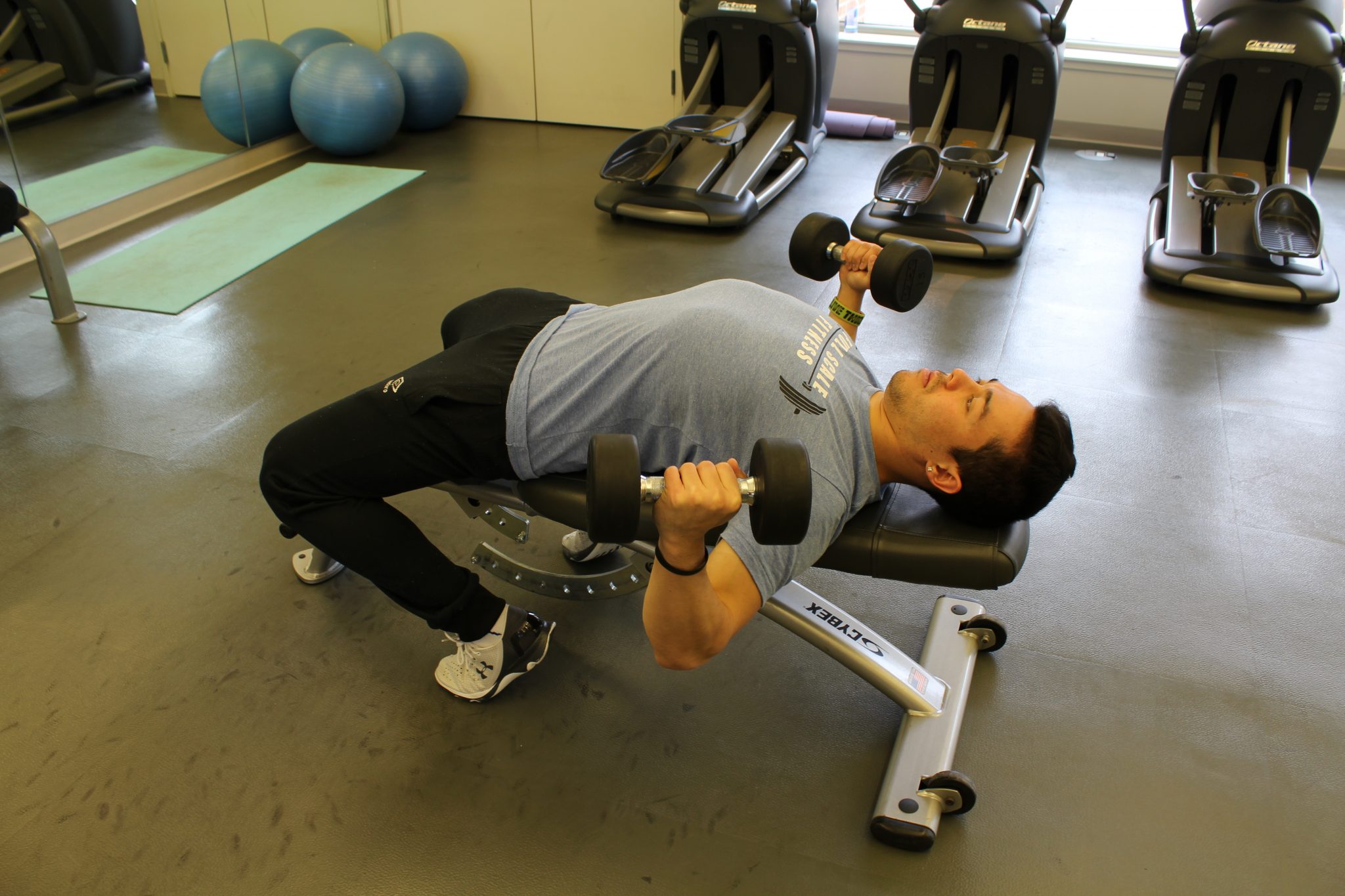If you want to get fit, strong and healthy, you need to have a good workout plan. But how do you decide what kind of plan to follow? Should you do full body workouts or split workouts? What are the benefits and drawbacks of each one? And which one is better for your specific needs? In this article, we will answer these questions and help you find the best way to train your body.
Table of Contents
What Are Full Body Workouts and Split Workouts?
Full-body workouts and split workouts are two common ways to organize your training sessions. They differ in how they divide your muscle groups and how often they target them.
A full-body workout is a type of workout that involves training all of your major muscle groups in one session. You can do this by performing compound exercises that work multiple muscles at once, such as squats, deadlifts, bench presses, rows, and lunges. You can also add some isolation exercises that focus on specific muscles, such as curls, extensions, and raises.

A split workout is a type of workout that involves training only one or a few muscle groups in one session. You can do this by performing exercises that isolate those muscles, such as the chest and triceps, back and biceps, legs, shoulders, and core. You can also mix some compound exercises that work those muscles along with other muscles, such as chest presses, pull-ups, leg presses, and shoulder presses.
What Are the Benefits of Full Body Workouts?

Full-body workouts are a great way to improve your overall fitness in a relatively short amount of time. They offer a number of benefits, such as:
- Increased strength: Full-body workouts help you build strength in all of your major muscle groups. This can improve your performance in everyday activities, as well as your athletic performance.
- Improved cardiovascular health: Full-body workouts can help improve your cardiovascular health by increasing your heart rate and breathing rate. This can help reduce your risk of heart disease, stroke, and other chronic diseases.
- Burn more calories: Full-body workouts can help you burn more calories than other types of workouts. This can help you lose weight or maintain a healthy weight. By working your whole body in one session, you also increase your metabolic rate and burn more calories during and after the workout.
- Stimulate muscle growth more often: Full-body workouts help you stimulate muscle growth more often by working on each muscle group at least twice a week. This provides more stimulus for hypertrophy and strength gains.
- Improved balance and coordination: Full-body workouts can help improve your balance and coordination. This can help reduce your risk of falls, especially as you get older.
- Reduced stress: Full-body workouts can help reduce stress and improve your mood. This is because exercise releases endorphins, which have mood-boosting effects.
- More flexibility if you miss a workout: Full-body workouts are more flexible if you miss a workout due to unforeseen circumstances. You won’t miss out on training any muscle group that week.
Full-body workouts are a versatile way to improve your overall fitness. They are suitable for beginners and experienced exercisers alike. You can do them at home, at the gym, or outdoors. You can use different equipment, such as dumbbells, kettlebells, resistance bands, or your own body weight. You can also vary the intensity, duration, and frequency of your workouts to suit your goals and preferences.
What Are the Benefits of Split Workouts?

Split workouts are a type of training where you focus on different muscle groups on different days. This allows you to train each muscle group more intensely and give it more time to recover. Split workouts have several advantages over full-body workouts, such as:
- Increased muscle growth and strength: Split workouts can help you build muscle and improve your strength more effectively than full-body workouts. This is because you can perform more sets, reps, and exercises for each muscle group and overload them more effectively.
- Reduced risk of injury and increased flexibility: Split workouts can help reduce your risk of injury and increase your flexibility by giving your muscles more time to recover and targeting different muscle groups. This can help improve your range of motion and prevent injury.
- More variety and customization: Split workouts can help you choose the exercises, sets, reps, and weights that suit your preferences and goals. You can also focus on your favorite muscles or body parts.
- More enjoyment for some people: Some people find split workouts more fun and motivating than full-body workouts, as they can concentrate on each muscle group.
Split workouts are a great option for building muscle or improving your strength, but they require more time and dedication than full-body workouts. If you’re short on time, full-body workouts may be a better option.
How to Choose Between Full Body Workouts and Split Workouts?
Full-body workouts and split workouts are two different ways to structure your strength training routine. Both have their advantages and disadvantages, depending on your goals, schedule, fitness level, and equipment availability. Here is a brief overview of each type of workout and how to choose the best one for you.
Full-body workouts involve working all of your major muscle groups in one session. This means you can train your entire body in a short amount of time, usually 30 to 60 minutes. Full-body workouts are ideal for people who want to improve their overall fitness, lose fat, or increase their metabolic rate. They also provide more frequency and consistency for your muscles, which can help you build strength and muscle mass faster.
However, full-body workouts also have some drawbacks. They can be very challenging and exhausting, as you are working more muscles at once. They also limit the amount of volume and intensity you can perform for each muscle group, as you have to balance the workload for your whole body. This can make it harder to target specific muscles or body parts that need more attention.
Split workouts involve working different muscle groups on different days. This means you can focus on each muscle group more intensely and give it more time to recover. Split workouts are ideal for people who want to build muscle mass, improve their strength in specific areas, or add more variety and customization to their routine. They also allow you to perform more sets, reps, and exercises for each muscle group, which can help you overload them more effectively.
However, split workouts also have some drawbacks. They require more time and dedication, as you have to work out more frequently and longer. They also increase the risk of injury and overtraining, as you are putting more stress on your muscles. They also reduce the calorie burn and fat loss potential of your workouts, as you are working fewer muscles per session.
Here is a table that summarizes the pros and cons of full-body workouts and split workouts:
| Full-body workouts | Split workouts |
|---|---|
| Pros | Pros |
|
|
| Cons | Cons |
|
|
How to choose?
To choose between full-body workouts and split workouts, consider the following factors:
- Your goals: If your main goal is to lose fat, full-body workouts may be more effective than split workouts, as they burn more calories and fat. If your main goal is to build muscle, split workouts may be more effective than full-body workouts, as they allow for more volume and intensity per muscle group.
- Your schedule: If you have a busy schedule or limited time to work out, full-body workouts may be more convenient than split workouts, as they require fewer sessions per week and less time per session. If you have a flexible schedule or plenty of time to work out, split workouts may be preferable to full-body workouts, as they require more sessions per week and more time per session.
- Your fitness level: If you are a beginner or have a low fitness level, full-body workouts may be more suitable than split workouts, as they provide more frequency and consistency for your muscles. If you are an intermediate or advanced lifter or have a high fitness level, split workouts may be more suitable than full body workouts, as they provide more challenge and variation for your muscles.
- Your equipment availability: If you have limited equipment or access to a gym, full body workouts may be easier to perform than split workouts, as they require fewer exercises and less equipment. If you have a lot of equipment or access to a gym, split workouts may be easier to perform than full body workouts, as they require more exercises and more equipment.
Ultimately, the best way to choose between full-body workouts and split workouts is to experiment and see what works best for you. Try both types of workouts and see which one you enjoy more and gives you better results. You may find that you like to switch between the two depending on your goals and fitness level. The most important thing is to be consistent with your training and follow a program that suits your needs.
Conclusion
Full-body workouts and split workouts are both effective ways to train your body and achieve your fitness goals. The best one for you depends on your personal preferences, needs, and circumstances. To find out which one works better for you, you can experiment with both types of workouts and see how your body responds. You can also combine them or switch between them from time to time to keep your training fresh and exciting.
We hope this article has helped you understand the differences, pros, and cons of full-body workouts and split workouts, and how to choose the best one for you. If you need any help with creating your own workout plan or finding the best exercises for your goals, feel free to contact us or use our online tools.
Frequently Asked Questions
is it better to do full body workouts or split?
It depends on your goals, fitness level, time and equipment availability, and personal preferences.
Full-body workouts involve working all of your major muscle groups in a single workout. This is a great option if you're short on time, as you can get a full-body workout done in as little as 30 minutes. Full-body workouts also tend to be more challenging than split workouts, as you're working more muscle groups at once. This can help you build strength and muscle mass more quickly.
Split workouts involve working different muscle groups on different days. This allows you to focus on each muscle group more intensely and give it more time to recover. Split workouts are a good option if you're looking to build muscle or improve your strength in specific areas. However, they require more time and dedication than full-body workouts.
| Factor | Full-body workouts | Split workouts |
|---|---|---|
| Target muscle groups | All major muscle groups | Specific muscle groups |
| Frequency | 2-3 times per week | 3-4+ times per week |
| Time commitment | 30-60 minutes per workout | 45-90 minutes per workout |
| Intensity | Moderate-high | High |
| Recovery | Shorter recovery time between workouts | Longer recovery time between workouts |
| Benefits |
|
|
| Drawbacks |
|
|
The best type of workout for you will depend on your individual goals, schedule, and fitness level. If you're a beginner, full-body workouts may be a better option. They're a great way to get started with strength training and build a foundation of strength. If you're more advanced and want to focus on building muscle mass in specific areas, split workouts may be a better option. They allow you to give each muscle group more time to recover and grow.
Ultimately, the best way to decide which type of workout is right for you is to experiment and see what works best for you. Try both types of workouts and see which one you prefer. You may find that you prefer to switch between the two depending on your goals and fitness level.
Here are some additional factors to consider when choosing between full-body workouts and split workouts:
- Your experience level: If you're new to strength training, full-body workouts may be a better option. This is because they allow you to focus on the basic exercises and movements, which is important for beginners.
- Your injury history: If you have a history of injuries, full-body workouts may be a better option. This is because they allow you to give your muscles more time to recover between workouts.
- Your personal preference: Ultimately, the best way to choose between full-body workouts and split workouts is to choose the type of workout that you enjoy the most. If you enjoy working out, you're more likely to stick with it and see results.
What are some compound exercises for full body workouts?
Some compound exercises for full-body workouts are:
- Squat with an overhead press: This exercise works your legs, core, shoulders, and arms. You can do it with dumbbells or a barbell. To perform it, stand with your feet shoulder-width apart and hold the weights at your shoulders. Squat down until your thighs are parallel to the floor, then push up and press the weights overhead. Lower the weights back to your shoulders and repeat.
- Squat, curl, and press: This exercise works your legs, core, biceps, and shoulders. You can do it with dumbbells or a kettlebell. To perform it, stand with your feet slightly wider than your hips and hold the weight in front of you. Squat down and touch the weight to the floor, then curl it up to your chest. Stand up and press the weight overhead, then lower it back to your chest and repeat.
- Deadlift row: This exercise works your hamstrings, glutes, back, and biceps. You can do it with dumbbells or a barbell. To perform it, stand with your feet hip-width apart and hold the weight in front of you. Hinge at your hips and lower the weight to just below your knees, keeping your back straight. Pull the weight up to your chest in a rowing motion, squeezing your shoulder blades together. Lower the weight back to your knees and repeat.
- Bench press: This exercise works your chest, triceps, and shoulders. You can do it with dumbbells or a barbell on a flat, incline, or decline bench. To perform it, lie on your back on the bench and hold the weight over your chest with your arms extended. Lower the weight to your chest level, then press it back up and repeat.
- Pull-up: This exercise works your back, biceps, and forearms. You can do it with a pull-up bar or a suspension trainer. To perform it, grab the bar or handles with an overhand grip, slightly wider than shoulder-width apart. Pull yourself up until your chin is above the bar or handles, then lower yourself back down and repeat. You can vary the grip width and direction to target different muscles.
How many sets and reps should I do for compound exercises?
The number of sets and reps you should do for compound exercises depends on your goals, fitness level, experience, and recovery ability. However, some general guidelines are:
- If your goal is to build strength, you should do 2 to 6 sets of 1 to 6 reps with heavy weights (80-95% of your one-rep max) for compound exercises like squats, deadlifts, bench presses, and overhead presses. You should rest for 2 to 5 minutes between sets to allow for full recovery.
- If your goal is to build muscle size, you should do 3 to 6 sets of 8 to 12 reps with moderate weights (65-75% of your one-rep max) for compound exercises. You should rest 60 to 90 seconds between sets to create metabolic stress and muscle damage.
- If your goal is to build endurance, you should do 1 to 3 sets of 15 to 20 reps with light weights (50-60% of your one-rep max) for compound exercises. You should rest 30 seconds or less between sets to increase muscular endurance and cardiovascular fitness.

